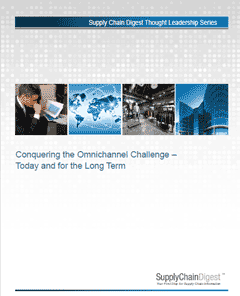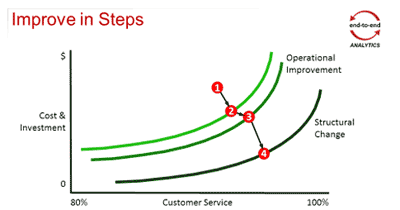 |
September 25, 2015 - Supply Chain Flagship Newsletter |
 |
| FEATURED SPONSOR: MSU |
||
 |
||
 |
|
||||||||||||||||||||||||||||||||||||||||||||||||||||||||||||||||||||||||||||||||||||||||||
"Let me station myself squarely in the "tradeoff curves exist" camp. Moreover, I'd say they're quite useful," Davis went on. "Most managers intuitively grasp the concept, and it's easy to transition from the underpinning math to the important concepts of what you called "curve shifting." What starts as a theoretical discussion generally ends up being quite practical." Davis said he recently made a conference presentation that included material on tradeoff curves, which included the graphic below, not dissimilar from what we published last week from Logility's Sean Willems but worth repeating. "I offer this material as evidence supporting the relevance of these trade-off curves. For all the terrific high-end math we apply on our projects at End-to-End Analytics, a good number of them start with simple discussions and pictures like these drawn on a whiteboard," Davis said.
He noted in his email that one of the really tricky aspects of this analysis is pinning down a service target. "Good stuff," he concluded. "It's great to see you picking up material that's at the intersection of serious analytics and practical supply chain management. "
|
|||||||||||||||||||||||||||||||||||||||||||||||||||||||||||||||||||||||||||||||||||||||||||
That includes comments on a recent OnTarget article we published on reports of challenges at Target stores keeping their shelves well stocked. "In many respects, both companies seem to be "grasping at straws," attempting to fix problems and it appears without much improvement," Armstrong notes. Armstrong said that he possesses lot of first hand knowledge and experience in store stocking operations in retail. He says that "A problem that I have observed is that in many cases, store managers are handcuffed by corporate policies and directions that effectively limit their ability to be more successful in this area. " Below are a number of examples from Armstrong on these challenges: • Store staffing is driven by store budgets which are closely tied to sales projections. Yet in-bound freight arrives in stores in advance of projected sales, particularly at this time of year as stores build inventory for the holiday season. If they don't increase staffing to handle the growth, the backup in the back room builds rapidly. All great observations. Meanwhile, Chad Smith of UPS offered some cogent thoughts on my piece on "No You Can't Track People Like FedEx Packages," stemming from comments made by presidential candidate Chris Christy relative to tracking immigrants into the US. "I think jumping to the "how" (using barcodes for example) is premature. And I'm sure we would need to further explore the "should we" question as well," Smith wrote, "However, I look at this differently than how your article and perhaps how most people do. I would want to know what check-in places most "Visa" holders have to visit. I would be looking at transaction locations because that's how we do it in the transportation industry. We have methods (processes, people and technology) at each of those known points to help us track packages. They don't send up some signal to a satellite and we don't know where every package is precisely at every moment. We know where it was last, where it's going and the 3 or 4 routes it most likely will be taking in between those two points." So he thinks that if a person with a Visa is here for educational purposes, the US should design processes that could be seamlessly implemented at those locations. If the government wanted to see where a Visa holder was, it might pull up a "timeline view," Smith suggests. For instance, the government could see that a given individual was at State University on a given date (paid tuition, ate at the student center, paid a parking fine, etc.). If a person was here for work purposes, you could do something similar at the employer or the bank where a paycheck check is to be deposited. I think in the end Smith comes out not far away from my observations, with Christie's notion that when the Visa expires we tap the immigrant on the shoulder and say "Time to go" (real-time tracking) is not happening any time soon. That said, news this week that a California school district is considering use of iris scanners on school buses after the tragic death on special needs students. In my column, I noted that this was actually a potential way to achieve something like real-time tracking - ala The Minority Report - but was hoping it was an issue for many years from now. Maybe not. Finally, after my annual "The Labor (Day) Supply Chain" column a few weeks ago, we received this thoughtful letter from Jerry Saltzman of Pfizer. First, we're once again happy for another compliment, with Saltzman writing that "It is notable that a frank, open column on labor is published. This is a serious issue for our economy." He adds some interesting observations. "Working class, unionized labor [once] made up a significant part of the America's middle class. Two generations ago, a high school graduate could move into the middle class working in manufacturing, which was largely unionized," he wrote. He adds that "It would be interesting to map the fall of union membership with the drop in US manufacturing attributable to globalization. Would the drop in US manufacturing parallel the drop in union membership, or would the drop off of union membership be a steeper downward slope? " Lastly, he agrees with me that "the National Labor Relations Board's recent rulings which you described could be pivot points". "Keep the conversation going," he concludes. All good stuff. Join the party. I know it takes some time to offer your thoughts, but it's greatly appreciated by all. We will always keep your name and company anonymous upon request. Will be in San Diego next week for CSCMP. Please say hello if you see me. Daily video recaps coming next week.
|
|||||||||||||||||||||||||||||||||||||||||||||||||||||||||||||||||||||||||||||||||||||||||||
|
|||||||||||||||||||||||||||||||||||||||||||||||||||||||||||||||||||||||||||||||||||||||||||
|
|||||||||||||||||||||||||||||||||||||||||||||||||||||||||||||||||||||||||||||||||||||||||||
|
|
|
YOUR FEEDBACK
We received quite a bit of Feedback on last week's First Thoughts column on "The Supply Chain Efficient Frontier," in addition to the great email from Tom Davis featured above. Below are some additional Feedbacks. More next week.
Feedback on the Efficient Supply Chain Frontier
I don't really care if I get mentioned personally, but I did the first off the self commercial work on supply chain trade off curves when I was a scientist/programmer for IBM. I ended up applying for a patent with them, and won an award for it. The patent application covered graphical interaction with trade off curves in a general way that didn't mention supply chain in particular. I'm not sure if IBM followed through in terms of actually acquiring the patent. (I no longer work for IBM). But if they did, I have a good understanding of what it does and doesn't cover. I also published some algorithmic ideas with IBM that are in the public domain. It's worth pointing out that computing a trade off curve for a reasonably sized optimization problem is more "parallelizable" than computing a single optimal result for a really hard optimization problem. That is to say, if your optimization problem is really hard, then adding 100 computers to work on it parallel will be unlikely to give you a 100X (or even a 10X) speed up. But if you're optimization problem doesn't take that long to solve in one instance, and you need to solve 100 somewhat similar instances in order to compute a trade off curve, then 100 machines might actually get you (almost) a 100X improvement (and even more likely a 10X improvement). As we move into a cloud computing world, where 100 computers are not terribly hard to rent, this observation becomes more prescient. Hopefully, when combined with articles like this, it will result in trade off curves becoming a more common part of data analysis in general, and supply chain analysis in particular. Peter Cacioppi
|
||
Nice Article. We would like to understand how these curves are drawn and how we can understand them better. |
||
GREAT SUMMARY! One of Sean's last points was interesting. It leads to the question "Are we working on the right projects - the ones that will actually move the dot in the right direction?" But that’s another story. Bill Pritz
|
||
SUPPLY CHAIN TRIVIA ANSWER
Q: What is the long-term (40 year) average manufacturing capacity utilization in the US?
A: 78.8%. In August, utilization was 75.8%. The measure has never reached whatever the current 40-year average is since the downturn in 2008.
| © SupplyChainDigest™ 2003-2015. All Rights Reserved. SupplyChainDigest PO Box 714 Springboro, Ohio 45066 |
POWERED BY: XDIMENSION
|









